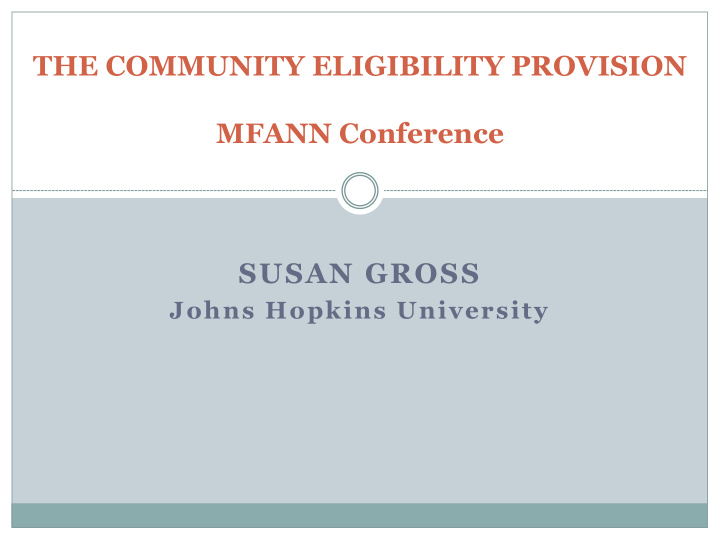



THE COMMUNITY ELIGIBILITY PROVISION MFANN Conference SUSAN GROSS Johns Hopkins University
The Community Eligibility Provision Community eligibility uses federal funding to allow schools to provide free breakfast and lunch to all students Removes barriers to participation in school meals, including the stigma that theses programs are only for “poor” children
The Community Eligibility Provision Schools without Schools with Community Eligibility Community Eligibility Individual eligibility for free Eligibility for free school or reduced-price meals is meals is determined at the based on family’s income school or “community” level
Free & Reduced Meal Forms --- Community Eligibility Eligibility based on CEP eligibility based on FARMs forms existing poverty data Free Meals “Identified students” Supplemental Nutrition Students with household Assistance Program (SNAP) incomes <130% of the TANF Federal Poverty Line Homeless Reduced-Price Meals Migrant Students with household Foster care incomes between 130% Head Start and 185% of the Federal Poverty Line “Identified student” rate must be >40% to qualify a school for CEP
Feeding Baltimore’s Students: The Impact of the Community Eligibility Provision JOHNS HOPKINS BLOOMBERG SCHOOL OF PUBLIC HEALTH MARYLAND HUNGER SOLUTIONS JOHNS HOPKINS CENTER FOR A LIVABLE FUTURE
Research Question What impact does Baltimore City Public Schools ’ implementation of the Community Eligibility Provision have on Baltimore City students? School meal participation Absenteeism Tardiness Suspensions Discipline referrals School nurse visits Academic achievement School advancement and graduation Food security status
School-level Data Analysis -- Methods Public use data was extracted from the Maryland State Department of Education for 214 BCPS and 196 schools in a comparison district (CDPS) in a nearby county School years: 2012-13 to 2016-17 School-level outcomes School meal participation: All Grade 10 promotion rate: High Changes from baseline (2012-13) were calculated for each district using SPSS GradPack and compared over time using Joinpoint Regression Program for a select outcome. All comparisons were made between BCPS and CDPS schools not participating in CEP
Preliminary Results Measure Grade Change from 2012-13 to Level 2016-17 (mean)* BCPS CDPS Grade 10 promotion rate High +3.91% 0.00% Graduation rate High -2.65% +1.08% Change from 2014-15 to 2015-16 All +1.89% +3.41% Average daily participation (ADP) school breakfast ADP school lunch All +20.56% +1.06%
Joinpoint Regression: Grade 10 Promotion Rate
Household Food Security Survey -- Methods Online Survey 5 Baltimore City Public Schools 3 Matched schools from one other school district Recruitment Flyers sent home with survey link/Onsite School Activities (iPAD) Consent collected at beginning Measurement USDA food insecurity screening tool was used to measure food insecurity rates Two- points in time (Spring and Fall, 2017) Spring 2017 Responses 57 Comparison District Public Schools (CDPS) responses 180 BCPS responses
USDA Food Insecurity Screening “I worried whether our food would run out before I got money to buy more.” Was that often, sometimes, or never true for (you/your household) in the last 12 months? “ The food that I bought just didn’t last, and I didn’t have money to get more.” “I couldn’t afford to eat balanced meals .” “In the last 12 months, did you or other adults in your household ever cut the size of your meals or skip meals because there wasn't enough money for food ?”
Defining Food Security FOOD SECURE: Raw scores of 0-1 indicate high or marginal food security, referred to generally as “food security.” LOW FOOD SECURITY: Raw scores of 2-4 indicate low food security, which is characterized by reduced quality, variety or desirability of the diet. VERY LOW FOOD SECURITY: Raw scores of 5-6 indicate very low food security, which is characterized by disrupted eating patterns and reduced food intake. Low food security and very low food security are combined to represent food insecurity.
Food Security Status of Selected Maryland Public Schools (n=237) Very Low Food Security Low Food Security High/Marginal Food Security Preliminary Data: Spring 2017 Food insecurity higher than expected
Food Security Status by CEP Participation Preliminary Data: Spring 2017 Schools Participating 100.0% in CEP more food secure 80.0% 60.0% 40.0% 20.0% 0.0% Marginal Low Very Low All CEP Eligible not Participating CEP Participating
Food Security Status by CEP Status and Ethnicity Total Non-Hispanic Hispanic Population CEP Participating 57.9 CEP Eligible 71.7 71.3 68.2 43.8 Percent non- Percent participating 37.1 34.3 31.5 28.6 26.3 24.7 15.8 22.7 15 14.5 13.8 13.8 9.1 High Food Low Food Very Low Food High Food Low Food Very Low Food Security Security Security Security Security Security Food Security Status Food Security Status Preliminary Data: Spring 2017 CEP Participation especially protective for Hispanic households
Parent Focus Group -- Preliminary Results Impact of CEP on Food Availability “ Before [CEP], if they didn't qualify for free lunch, we were packing them lunch. Sometimes, when you don't have a lot of money to buy groceries or food for the children, you don't send them with food at school. Now, all the children have free food, the breakfast, and the lunch. I think that it is good for everybody.” “I think it's great there is this [CEP] program. I know from a fact that there is a lot of families that the only meal they have here is at this school.” “… maybe at the time when you apply [for free and reduced-price school meals] you don't need it, but things can change throughout the year. Sometimes, there is more work than other times. It can get messy and is a problem. The kids should always be able to have food at the table .”
Acknowledgements Maryland Hunger Solutions Michael J. Wilson Tam Lynne Kelley Johns Hopkins Bloomberg School of Public Health Marycatherine Augustyn Elizabeth Brown Emily Payne Dana Stretchberry Lacy Boyle Johns Hopkins Center for a Livable Future Anne Palmer Karen Bassarab Claire Fitch
Questions?
Recommend
More recommend